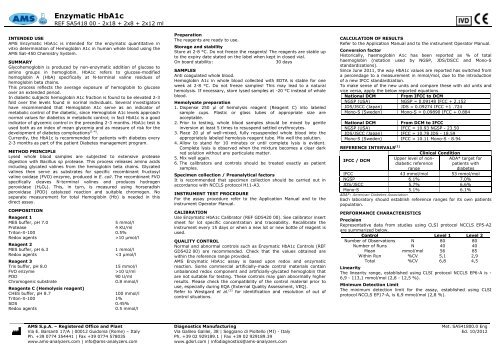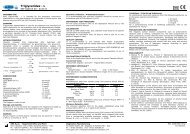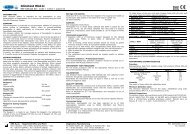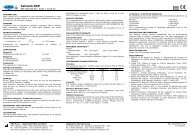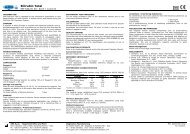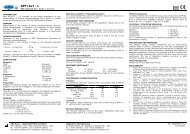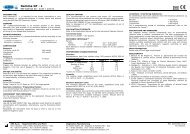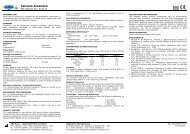Enzymatic HbA1c - Gdsrl.com
Enzymatic HbA1c - Gdsrl.com
Enzymatic HbA1c - Gdsrl.com
You also want an ePaper? Increase the reach of your titles
YUMPU automatically turns print PDFs into web optimized ePapers that Google loves.
<strong>Enzymatic</strong> <strong>HbA1c</strong><br />
REF SA5418 00 - 2x18 + 2x8 + 2x12 ml<br />
INTENDED USE<br />
AMS <strong>Enzymatic</strong> <strong>HbA1c</strong> is intended for the enzymatic quantitative in<br />
vitro determination of Hemoglobin A1c in human whole blood using the<br />
AMS Sat-450 Chemistry System.<br />
SUMMARY<br />
Glycohemoglobin is produced by non-enzymatic addition of glucose to<br />
amino groups in hemoglobin. <strong>HbA1c</strong> refers to glucose-modified<br />
hemoglobin A (HbA) specifically at N-terminal valine residues of<br />
hemoglobin beta chains.<br />
This process reflects the average exposure of hemoglobin to glucose<br />
over an extended period.<br />
In diabetic subjects hemoglobin A1c fraction is found to be elevated 2-3<br />
fold over the levels found in normal individuals. Several investigators<br />
have re<strong>com</strong>mended that Hemoglobin A1c serve as an indicator of<br />
metabolic control of the diabetic, since Hemoglobin A1c levels approach<br />
normal values for diabetics in metabolic control; in fact <strong>HbA1c</strong> is a good<br />
indicator of glycemic control in the preceding 2-3 months. <strong>HbA1c</strong> test is<br />
used both as an index of mean glycemia and as measure of risk for the<br />
development of diabetes <strong>com</strong>plications (1-4) .<br />
Currently, the <strong>HbA1c</strong> is re<strong>com</strong>mended for patients with diabetes every<br />
2-3 months as part of the patient Diabetes management program.<br />
METHOD PRINCIPLE<br />
Lysed whole blood samples are subjected to extensive protease<br />
digestion with Bacillus sp protease. This process releases amino acids<br />
including glycated valines from the hemoglobin beta chains. Glycated<br />
valines then serve as substrates for specific re<strong>com</strong>binant fructosyl<br />
valine oxidase (FVO) enzyme, produced in E. coli. The re<strong>com</strong>binant FVO<br />
specifically cleaves N-terminal valines and produces hydrogen<br />
peroxidase (H2O2). This, in turn, is measured using horseradish<br />
peroxidase (POD) catalyzed reaction and suitable chromogen. No<br />
separate measurement for total Hemoglobin (Hb) is needed in this<br />
direct assay.<br />
COMPOSITION<br />
Reagent 1<br />
MES buffer, pH 7.0 5 mmol/l<br />
Protease 4 KU/ml<br />
Triton-X-100 0.5%<br />
Redox agents >10 µmol/l<br />
Reagent 2<br />
MES buffer, pH 6.3 1 mmol/l<br />
Redox agents 10 U/ml<br />
POD 90 U/ml<br />
Chromogenic substrate 0.8 mmol/l<br />
Reagente C (Hemolysis reagent)<br />
CHES buffer, pH 8.7 100 mmol/l<br />
Triton-X-100 1%<br />
SDS 0.45%<br />
Redox agents 0.5 mmol/l<br />
Preparation<br />
The reagents are ready to use.<br />
Storage and stability<br />
Store at 2-8 °C. Do not freeze the reagents! The reagents are stable up<br />
to the expiry date stated on the label when kept in closed vial.<br />
On board stability: 30 days<br />
SAMPLES<br />
Anti coagulated whole blood.<br />
Hemoglobin A1c in whole blood collected with EDTA is stable for one<br />
week at 2-8 °C. Do not freeze samples! This may lead to a natural<br />
hemolysis. If necessary, store lysed samples at -20 °C instead of whole<br />
blood.<br />
Hemolysate preparation<br />
1. Dispense 250 µl of hemolysis reagent (Reagent C) into labeled<br />
sample cups. Plastic or glass tubes of appropriate size are<br />
acceptable.<br />
2. Prior to testing, whole blood samples should be mixed by gentle<br />
inversion at least 5 times to resuspend settled erythrocytes.<br />
3. Place 20 µl of well-mixed, fully resuspended whole blood into the<br />
appropriately labeled hemolysis reagent tube. Mix well the solution.<br />
4. Allow to stand for 10 minutes or until <strong>com</strong>plete lysis is evident.<br />
Complete lysis is observed when the mixture be<strong>com</strong>es a clear dark<br />
red solution without any particulate matter.<br />
5. Mix well again.<br />
6. The calibrators and controls should be treated exactly as patient<br />
samples.<br />
Specimen collection / Preanalytical factors<br />
It is re<strong>com</strong>mended that specimen collection should be carried out in<br />
accordance with NCCLS protocol H11-A3.<br />
INSTRUMENT TEST PROCEDURE<br />
For the assay procedure refer to the Application Manual and to the<br />
instrument Operator Manual.<br />
CALIBRATION<br />
Use <strong>Enzymatic</strong> <strong>HbA1c</strong> Calibrator (REF GD5420 00). See calibrator insert<br />
sheet for lot specific concentration and traceability. Recalibrate the<br />
instrument every 15 days or when a new lot or new bottle of reagent is<br />
used.<br />
QUALITY CONTROL<br />
Normal and abnormal controls such as <strong>Enzymatic</strong> <strong>HbA1c</strong> Controls (REF<br />
GD5422 00) are re<strong>com</strong>mended. Check that the values obtained are<br />
within the reference range provided.<br />
AMS <strong>Enzymatic</strong> <strong>HbA1c</strong> assay is based upon redox and enzymatic<br />
reaction. Some <strong>com</strong>mercial artificially-made control materials contain<br />
unbalanced redox <strong>com</strong>ponent and artificially-glycated hemoglobin that<br />
are not suitable for testing. These controls may gain abnormally higher<br />
results. Please check the <strong>com</strong>patibility of the control material prior to<br />
use, especially during EQA (External Quality Assessment, VEQ).<br />
Refer to Westgard et al. (3) for identification and resolution of out of<br />
control situations.<br />
AMS S.p.A. – Registered Office and Plant Diagnostics Manufacturing<br />
Via E. Barsanti 17/A | 00012 Guidonia (Rome) – Italy Via Galileo Galilei, 38 | Seggiano di Pioltello (MI) - Italy<br />
Ph. +39 0774 354441 | Fax +39 0774 578035 Ph. +39 02 929189.1 | Fax +39 02 929189.39<br />
www.ams-analyzers.<strong>com</strong> | info@ams-analyzers.<strong>com</strong> www.gdsrl.<strong>com</strong> | infodiagnostics@ams-analyzers.<strong>com</strong><br />
CALCULATION OF RESULTS<br />
Refer to the Application Manual and to the instrument Operator Manual.<br />
Conversion factor<br />
Historically, haemoglobin A1c has been reported as % of total<br />
haemoglobin (notation used by NGSP, JDS/DSCC and Mono-S<br />
standardizations).<br />
Since June 2011, the way <strong>HbA1c</strong> values are reported has switched from<br />
a percendage to a measurement in mmol/mol, due to the introduction<br />
of a new IFCC standardization.<br />
To make sense of the new units and <strong>com</strong>pare these with old units and<br />
vice versa, apply the below reported equations.<br />
National DCM From IFCC to DCM<br />
NGSP (USA) NGSP = 0.09148 IFCC + 2.152<br />
JDS/JSCC (Japan) JDS = 0.09274 IFCC +1 .724<br />
Mono-S (Sweden) Mono-S = 0.09890 IFCC + 0.884<br />
National DCM From DCM to IFCC<br />
NGSP (USA) IFCC = 10.93 NGSP - 23.50<br />
JDS/JSCC (Japan) IFCC = 10.78 JDS - 18.59<br />
Mono-S (Sweden) IFCC = 10.11 Mono-S - 8.94<br />
REFERENCE INTERVALS (1)<br />
IFCC / DCM<br />
Upper level of nondiabetic<br />
reference<br />
range<br />
Clinical Condition<br />
ADA* target for<br />
patients with<br />
diabetes<br />
IFCC 43 mmol/mol 53 mmol/mol<br />
NGSP 6.1% 7.0%<br />
JDS/JSCC 5.7% 6.6%<br />
Mono-S 5.1% 6.1%<br />
ADA*: American Diabetes Association<br />
Each laboratory should establish reference ranges for its own patients<br />
population.<br />
PERFORMANCE CHARACTERISTICS<br />
Precision<br />
Representative data from studies using CLSI protocol NCCLS EP5-A2<br />
are summarized below.<br />
Control Level 1 Level 2<br />
Number of Observations N 80 80<br />
Number of Runs N 40 40<br />
Mean mmol/mol 56 85<br />
Within Run %CV 5,1 2,9<br />
Total %CV 6,8 4,5<br />
Linearity<br />
The linearity range, established using CLSI protocol NCCLS EP6-A is -<br />
6,9 - 113,1 mmol/mol (2,8 - 12,5 %).<br />
Minimum Detection Limit<br />
The minimum detection limit for the assay, established using CLSI<br />
protocol NCCLS EP17-A, is 6,9 mmol/mol (2,8 %).<br />
Met. SA541800.0 Eng<br />
Ed. 10/2012
<strong>Enzymatic</strong> <strong>HbA1c</strong><br />
REF SA5418 00 - 2x18 + 2x8 + 2x12 ml<br />
Method Comparison<br />
Correlation studies were performed using CLSI protocol NCCLS EP9-A2.<br />
Serum results from this assay on Sat-450 were <strong>com</strong>pared with those<br />
from a <strong>com</strong>mercially available analogous system. Results were as<br />
follows: N = 42, y = 1,006x - 1,09 mmol/mol, r = 0,978.<br />
Limitations / Interfering Substances<br />
1. The following other <strong>com</strong>ponents at the indicated concentrations do<br />
not interfere with this analytical method:<br />
Total Bilirubin: 15 mg/dl<br />
Conjugated Bilirubin: 13 mg/dl<br />
Ascorbic Acid: 12 mg/dl<br />
Triglycerides: 4000 mg/dl<br />
Glucose: 4000 mg/dl<br />
Uric Acid: 30 mg/dl<br />
Urea: 80 mg/dl<br />
2. Stable glycated hemoglobin serves as substrate for enzymatic<br />
reaction used by the present test. Acetylated, carbamylated and<br />
labile <strong>HbA1c</strong> does not adversely affect the enzymatic reaction used in<br />
this assay.<br />
3. Variant hemoglobin S, C and E do not significantly interfere with the<br />
assay.<br />
For a <strong>com</strong>prehensive review of interfering substances, refer to the<br />
publication by Young (2) .<br />
PRECAUTIONS AND WARNINGS<br />
The reagents contain inactive <strong>com</strong>ponents such as preservatives<br />
(Sodium azide or others), surfactants etc. The total concentration of<br />
these <strong>com</strong>ponents is lower than the limits reported by 67/548/EEC and<br />
88/379/EEC directives about classification, packaging and labelling of<br />
dangerous substances. However, the reagents should be handled with<br />
caution, avoiding swallowing and contact with skin, eyes and mucous<br />
membranes. The use of laboratory reagents according to good<br />
laboratory practice is re<strong>com</strong>mended.<br />
Waste Management<br />
Please refer to local legal requirements.<br />
BIBLIOGRAPHY<br />
1. American Diabetes Association (ADA). Clinical practice<br />
re<strong>com</strong>mendation: standards of medical care for patients with<br />
diabetes mellitus. Diab Care 22 (supp): S32-41 (1999).<br />
2. Young D.S., Effects of Drugs on Clinical Laboratory Tests, AACC<br />
Press, Washington, D.C., 1990.<br />
3. Westgard J., and Barry P., Cost- Effective Quality Control:<br />
Managing the Quality and Productivity of Analytical Processes,<br />
AACC Press, Washington, D.C., 1986.<br />
4. Goldstein, D.E. et al., Diabetes Care. 27(7):1761-73 (2994).<br />
5. United Kingdom Prospective study, Lancet 352:837-53 (1998).<br />
6. The Diabetes Control and Complications Trial Research Group, N.<br />
Engl. J. Med. 329:977-86 (1993).<br />
7. Little, R. et al., Clin Chemistry, 47:1985-1992 (2001).<br />
8. American Diabetes Association (ADA). Clinical Practice<br />
re<strong>com</strong>mendation, Diab Care 16S2 (93):10-13 (1992).<br />
9. American Diabetes Association (ADA). Clinical Practice<br />
re<strong>com</strong>mendation, Diabetes 42:1555-58 (1993).<br />
10. NGSP, http://www.missouri.edu/∼diabetes/ngsp.html<br />
11. Goldstein et al., Clin Chem 32:B64-B70 (1986).<br />
12. Hoelzel, W. et al., IFCC reference system for measurement of<br />
hemoglobin A1c in human blood and the national standardization<br />
schemes in the United States, Japan and Sweden: a method<br />
<strong>com</strong>parison study. Clin Chem 50:166-74 (2004).<br />
13. Sacks, D (ed). Global Harmonization of Hemoglobin A1c. Clin<br />
Chem 51(4):681-83 (2005).<br />
14. NCCLS Document, “Procedures for the collection of arterial blood<br />
specimens”, Approved Standard, 3rd Ed. (1999).<br />
15. EU-Dir 1999/11 Commission Directive of 8 March 1999 adapting to<br />
technical progress the principles of good laboratory practice as<br />
specified in Council Directive 87/18/EEC.<br />
AMS S.p.A. – Registered Office and Plant Diagnostics Manufacturing<br />
Via E. Barsanti 17/A | 00012 Guidonia (Rome) – Italy Via Galileo Galilei, 38 | Seggiano di Pioltello (MI) - Italy<br />
Ph. +39 0774 354441 | Fax +39 0774 578035 Ph. +39 02 929189.1 | Fax +39 02 929189.39<br />
www.ams-analyzers.<strong>com</strong> | info@ams-analyzers.<strong>com</strong> www.gdsrl.<strong>com</strong> | infodiagnostics@ams-analyzers.<strong>com</strong><br />
Met. SA541800.0 Eng<br />
Ed. 10/2012
<strong>Enzymatic</strong> <strong>HbA1c</strong><br />
REF SA5418 00 - 2x18 + 2x8 + 2x12 ml<br />
USO<br />
Il kit AMS <strong>Enzymatic</strong> <strong>HbA1c</strong> viene impiegato per la determinazione<br />
enzimatica quantitativa in vitro della emoglobina A1c nel sangue intero<br />
umano con sistema AMS Sat-450.<br />
SOMMARIO<br />
L’emoglobina glicata è prodotta dall’aggiunta non enzimatica di glucosio<br />
ai gruppi amminici presenti nell’emoglobina. La frazione <strong>HbA1c</strong> si<br />
riferisce in modo specifico ai residui N-terminali della valina nelle catene<br />
beta dell’emoglobina A (HbA).<br />
Questo processo riflette l’esposizione media dell’emoglobina al glucosio<br />
nel lungo periodo.<br />
Nei soggetti diabetici la frazione A1c dell’emoglobina è 2-3 volte più<br />
elevata rispetto a soggetti non diabetici. Parecchi studi hanno<br />
dimostrato che il dosaggio dell’emoglobina glicata è un importante<br />
indicatore del controllo metabolico dei diabetici, poiché i livelli di<br />
glicoemoglobina si approssimano a quelli normali in soggetti sotto<br />
controllo metabolico; difatti l’<strong>HbA1c</strong> è un ottimo indicatore del controllo<br />
glicemico nei 2-3 mesi precedenti al dosaggio.<br />
Il dosaggio dell’<strong>HbA1c</strong> è sfruttato sia <strong>com</strong>e indice del valore medio della<br />
glicemia, sia <strong>com</strong>e misura del rischio di insorgenza di <strong>com</strong>plicanze<br />
diabetiche (1-4) .<br />
Allo stato dell’arte, il dosaggio dell’<strong>HbA1c</strong> è rac<strong>com</strong>andato ai pazienti<br />
diabetici ogni 2-3 mesi <strong>com</strong>e parte del protocollo terapeutico.<br />
PRINCIPIO<br />
I campioni di sangue intero lisato sono sottoposti ad una estensiva<br />
digestione enzimatica tramite proteasi da Bacillus sp. Questo processo<br />
rilascia aminoacidi tra cui valina glicata dalle catene beta<br />
dell’emoglobina. La valina glicata serve quindi <strong>com</strong>e substrato per<br />
l’enzima ri<strong>com</strong>binante di E. Coli fructosil-valina ossidasi (FVO). L’FVO<br />
agisce in modo specifico sulla valina glicata producendo perossido<br />
d’idrogeno (H2O2). Quest’ultimo viene alla fine misurato tramite l’azione<br />
della perossidasi (POD) e un substrato cromogeno dedicato.<br />
Il dosaggio separato dell’emoglobina totale (Hb) non è necessario.<br />
COMPOSIZIONE<br />
Reagente 1<br />
Tampone MES, pH 7.0 5 mmol/l<br />
Proteasi 4 KU/ml<br />
Triton-X-100 0.5%<br />
Agenti redox >10 µmol/l<br />
Reagente 2<br />
Tampone MES, pH 6.3 1 mmol/l<br />
Agenti redox 10 U/ml<br />
POD 90 U/ml<br />
Substrato cromogeno 0.8 mmol/l<br />
Reagente C (reagente emolizzante)<br />
Tampone CHES, pH 8.7 100 mmol/l<br />
Triton-X-100 1%<br />
SDS 0.45%<br />
Agenti redox 0.5 mmol/l<br />
Preparazione<br />
I reagenti sono pronti all’uso.<br />
Conservazione e Stabilità<br />
Conservare a 2-8 °C. Non congelare i reattivi! I reattivi sono stabili fino<br />
alla data di scadenza riportata in etichetta, se conservati in flacone<br />
chiuso.<br />
Stabilità a bordo dello strumento: 30 giorni<br />
CAMPIONI<br />
Sangue intero anticoagulato.<br />
L’emoglobina A1c in campioni di sangue intero EDTA è stabile per una<br />
settimana a 2-8 °C. (5) Non congelare i campioni! Questo potrebbe<br />
determinare una lisi naturale. Se necessario, conservare i campioni<br />
lisati a -20 °C al posto del sangue intero.<br />
Preparazione dell’emolisato<br />
1. Dispensare 250 µl di reattivo emolizzante (RC) in coppette porta<br />
campione adeguatamente identificate. Provette di plastica o di vetro<br />
sono accettabili.<br />
2. Prima del dosaggio, i campioni di sangue intero devono essere<br />
miscelati invertendo delicatamente la provetta per almeno 5 volte<br />
per risospendere gli eritrociti sedimentati.<br />
3. Dispensare 20 µl di sangue intero ben miscelato e omogeneo nella<br />
rispettiva coppetta porta campione. Miscelare bene la soluzione.<br />
4. Attendere 10 minuti o fino a che la <strong>com</strong>pleta emolisi sia evidente. La<br />
lisi <strong>com</strong>pleta si osserva quando la miscela diventa di un colore rosso<br />
scuro senza particolato.<br />
5. Miscelare nuovamente.<br />
6. I calibratori e i controlli devono essere trattati esattamente <strong>com</strong>e i<br />
campioni dei pazienti.<br />
Raccolta dei Campioni / Fattori Preanalitici<br />
Si rac<strong>com</strong>anda di effettuare la raccolta dei campioni in conformità al<br />
Protocollo NCCLS H11-A3.<br />
PROCEDURA DI ANALISI<br />
Per la procedura di analisi fare riferimento all’Application Manual e al<br />
Manuale dell’Operatore dello strumento.<br />
CALIBRAZIONE<br />
Utilizzare <strong>Enzymatic</strong> <strong>HbA1c</strong> Calibrator (REF GD5420 00). Riferirsi<br />
all’inserto del calibratore per la concentrazione specifica del lotto e la<br />
tracciabilità.<br />
Ricalibrare lo strumento ogni 15 giorni o quando viene utilizzato un<br />
nuovo lotto o una nuova bottiglia di reagente.<br />
CONTROLLO DI QUALITA’<br />
Si consiglia l’uso di controlli Normale e Patologico <strong>com</strong>e <strong>Enzymatic</strong><br />
<strong>HbA1c</strong> Controls (REF GD5422 00). Verificare che il valore ottenuto sia<br />
all’interno degli intervalli di accettabilità forniti. Il presente reattivo si<br />
basa su reazioni enzimatiche e redox. Alcuni controlli <strong>com</strong>merciali<br />
prodotti artificialmente contengono <strong>com</strong>ponenti redox non bilanciati e<br />
emoglobine artificialmente glicate che sono in<strong>com</strong>patibili con questo<br />
reattivo. Questi controlli possono dare risultati estremamente elevati. Si<br />
consiglia di verificare la <strong>com</strong>patibilità del materiale di controllo prima<br />
dell’uso, soprattutto durante esercizi di programmi di qualità esterni<br />
(VEQ).<br />
AMS S.p.A. – Sede Legale e Stabilimento Produzione Diagnostici<br />
Via E. Barsanti 17/A | 00012 Guidonia (Roma) – Italia Via Galileo Galilei, 38 | Seggiano di Pioltello (MI) - Italia<br />
Tel. +39 0774 354441 | Fax +39 0774 578035 Tel. +39 02 929189.1 | Fax +39 02 929189.39<br />
www.ams-analyzers.<strong>com</strong> | info@ams-analyzers.<strong>com</strong> www.gdsrl.<strong>com</strong> | infodiagnostics@ams-analyzers.<strong>com</strong><br />
Far riferimento a Westgard et al. (3) per l’identificazione e la risoluzione<br />
di problematiche legate ai controlli fuori dai limiti.<br />
CALCOLO DEI RISULTATI<br />
Riferirsi all’Application Manual e al Manuale dell’Operatore dello<br />
strumento.<br />
Fattori di Conversione<br />
Storicamente, l’emoglobina A1c veniva riportata <strong>com</strong>e % della<br />
emoglobina totale (notazione adottata dalle standardizzazioni NGSP,<br />
JDS/DSCC e Mono-S).<br />
A partire da giugno 2011, il sistema di espressione dei risultati è<br />
cambiato dalla percentuale alla misura in mmol/mol, a causa<br />
dell’introduzione di una nuova standardizzazione IFCC.<br />
Per potere meglio interpretare i nuovi risultati e confrontare la nuove<br />
unità con quelle vecchie, è necessario applicare le equazioni sotto<br />
riportate.<br />
DCM Da IFCC a DCM<br />
NGSP (USA) NGSP = 0.09148 IFCC + 2.152<br />
JDS/JSCC (Japan) JDS = 0.09274 IFCC +1 .724<br />
Mono-S (Sweden) Mono-S = 0.09890 IFCC + 0.884<br />
DCM Da DCM a IFCC<br />
NGSP (USA) IFCC = 10.93 NGSP - 23.50<br />
JDS/JSCC (Japan) IFCC = 10.78 JDS - 18.59<br />
Mono-S (Sweden) IFCC = 10.11 Mono-S - 8.94<br />
VALORI DI RIFERIMENTO (1)<br />
IFCC / DCM<br />
Estremo superiore<br />
per pazienti non<br />
diabetici<br />
Condizione Clinica<br />
target ADA per<br />
pazienti diabetici<br />
IFCC 43 mmol/mol 53 mmol/mol<br />
NGSP 6.1% 7.0%<br />
JDS/JSCC 5.7% 6.6%<br />
Mono-S 5.1% 6.1%<br />
ADA*: American Diabetes Association<br />
Si rac<strong>com</strong>anda ad ogni laboratorio di stabilire i propri valori normali in<br />
funzione della popolazione su cui opera.<br />
PRESTAZIONI ANALITICHE<br />
Precisione<br />
Dati rappresentativi dello studio secondo il protocollo CLSI NCCLS<br />
EP5-A2 sono sotto riportati.<br />
Controllo Livello 1 Livello 2<br />
Numero di Osservazioni N 80 80<br />
Numero di Prove N 40 40<br />
Media mmol/mol 56 85<br />
Nella Corsa %CV 5,1 2,9<br />
Totale %CV 6,8 4,5<br />
Linearità<br />
L’intervallo di linearità, stabilito tramite il protocollo CLSI NCCLS EP6-A<br />
è risultato pari a 6,9 - 113,1 mmol/mol (2,8 - 12,5 %).<br />
Met. SA541800.0 Ita<br />
Ed. 109/2012
<strong>Enzymatic</strong> <strong>HbA1c</strong><br />
REF SA5418 00 - 2x18 + 2x8 + 2x12 ml<br />
Limite Minimo di Rivelabilità<br />
Il limite minimo di rilevabilità, stabilito tramite il protocollo CLSI NCCLS<br />
EP17-A, è 6,9 mmol/mol (2,8 %).<br />
Comparazione fra Metodi<br />
Studi di correlazione sono stati effettuati secondo il protocollo CLSI<br />
NCCLS EP9-A2. I risultati dei sieri di questo dosaggio su Sat-450 sono<br />
stati confrontati con un sistema analogo presente in <strong>com</strong>mercio. I<br />
risultati sono stati i seguenti: N = 42, y = 1,006x - 1,09 mmol/mol, r =<br />
0,978.<br />
Limitazioni / Sostanze Interferenti<br />
1. Gli interferenti normalmente presenti nel sangue non<br />
interferiscono con il dosaggio fino alle concentrazioni sotto<br />
riportate:<br />
Bilirubina Totale: 15 mg/dl<br />
Bilirubina Coniugata: 13 mg/dl<br />
Acido Ascorbico: 12 mg/dl<br />
Trigliceridi: 4000 mg/dl<br />
Glucosio: 4000 mg/dl<br />
Acido Urico: 30 mg/dl<br />
Urea: 80 mg/dl<br />
2. Solo l’emoglobina glicata stabile serve da substrato per le reazioni<br />
enzimatiche impiegate dal dosaggio. Le emoglobine acetilate,<br />
carbamilate ed instabili non interferiscono nelle reazioni<br />
enzimatiche del dosaggio.<br />
3. Le varianti S, C e E dell’emoglobina non interferiscono<br />
significativamente con il dosaggio.<br />
Per una panoramica <strong>com</strong>pleta sulle sostanze interferenti si rimanda alla<br />
pubblicazione di Young (2) .<br />
PRECAUZIONI E AVVERTENZE<br />
I reagenti contengono <strong>com</strong>ponenti inattivi, quali i conservanti (Sodio<br />
azide o altri), tensioattivi ecc. La concentrazione totale di questi<br />
<strong>com</strong>ponenti è inferiore ai limiti riportati dalle direttive CEE 67/548/EEC<br />
e 88/379/EEC sulla classificazione, l’imballaggio ed etichettatura delle<br />
sostanze pericolose. Tuttavia i reagenti devono essere trattati con<br />
cautela, evitandone l’ingestione, il contatto con la pelle, gli occhi e le<br />
membrane mucose.<br />
Nell’utilizzo dei reagenti di laboratorio si rac<strong>com</strong>anda di seguire le<br />
norme di buona pratica di laboratorio.<br />
Gestione dei Rifiuti<br />
Attenersi alle norme locali per quanto riguarda lo smaltimento dei<br />
reagenti.<br />
BIBLIOGRAFIA<br />
1. American Diabetes Association (ADA). Clinical practice<br />
re<strong>com</strong>mendation: standards of medical care for patients with<br />
diabetes mellitus. Diab Care 22 (supp): S32-41 (1999).<br />
2. Young D.S., Effects of Drugs on Clinical Laboratory Tests, AACC<br />
Press, Washington, D.C., 1990.<br />
3. Westgard J., and Barry P., Cost- Effective Quality Control:<br />
Managing the Quality and Productivity of Analytical Processes,<br />
AACC Press, Washington, D.C., 1986.<br />
4. Goldstein, D.E. et al., Diabetes Care. 27(7):1761-73 (2994).<br />
5. United Kingdom Prospective study, Lancet 352:837-53 (1998).<br />
6. The Diabetes Control and Complications Trial Research Group, N.<br />
Engl. J. Med. 329:977-86 (1993).<br />
7. Little, R. et al., Clin Chemistry, 47:1985-1992 (2001).<br />
8. American Diabetes Association (ADA). Clinical Practice<br />
re<strong>com</strong>mendation, Diab Care 16S2 (93):10-13 (1992).<br />
9. American Diabetes Association (ADA). Clinical Practice<br />
re<strong>com</strong>mendation, Diabetes 42:1555-58 (1993).<br />
10. NGSP, http://www.missouri.edu/∼diabetes/ngsp.html<br />
11. Goldstein et al., Clin Chem 32:B64-B70 (1986).<br />
12. Hoelzel, W. et al., IFCC reference system for measurement of<br />
hemoglobin A1c in human blood and the national standardization<br />
schemes in the United States, Japan and Sweden: a method<br />
<strong>com</strong>parison study. Clin Chem 50:166-74 (2004).<br />
13. Sacks, D (ed). Global Harmonization of Hemoglobin A1c. Clin<br />
Chem 51(4):681-83 (2005).<br />
14. NCCLS Document, “Procedures for the collection of arterial blood<br />
specimens”, Approved Standard, 3rd Ed. (1999).<br />
15. EU-Dir 1999/11 Commission Directive of 8 March 1999 adapting to<br />
technical progress the principles of good laboratory practice as<br />
specified in Council Directive 87/18/EEC.<br />
AMS S.p.A. – Sede Legale e Stabilimento Produzione Diagnostici<br />
Via E. Barsanti 17/A | 00012 Guidonia (Roma) – Italia Via Galileo Galilei, 38 | Seggiano di Pioltello (MI) - Italia<br />
Tel. +39 0774 354441 | Fax +39 0774 578035 Tel. +39 02 929189.1 | Fax +39 02 929189.39<br />
www.ams-analyzers.<strong>com</strong> | info@ams-analyzers.<strong>com</strong> www.gdsrl.<strong>com</strong> | infodiagnostics@ams-analyzers.<strong>com</strong><br />
Met. SA541800.0 Ita<br />
Ed. 109/2012


